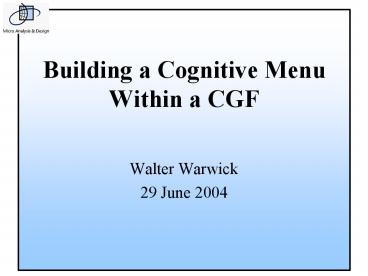Building a Cognitive Menu Within a CGF - PowerPoint PPT Presentation
1 / 12
Title:
Building a Cognitive Menu Within a CGF
Description:
subscription mgr. lib. data handler. lib. Squad clear. building ... Subscription Mgr. Receive COM. message. Send COM. message. Micro. Saint. External. Variables ... – PowerPoint PPT presentation
Number of Views:52
Avg rating:3.0/5.0
Title: Building a Cognitive Menu Within a CGF
1
Building a Cognitive Menu Within a CGF
- Walter Warwick
- 29 June 2004
2
Overview
- The problem
- The approach
- A new problem
- Why bother?
3
The Problem
- The behavioral realism of the synthetic entities
that populate CGFs is lacking - rigid, brittle and buggy
- impacts the use of MS in both analysis and
training - divorced from theory
- No easy avenue for remediation
- no one wants you to mess with their VVd library
and no one wants to start over - lots of one-off efforts to hook individual
behaviors
4
One Approach to the Problem
- Identify the human behaviors within the CGF
- Expose selected behaviors to external control via
a client server architecture - following sensors and effectors (SA and decision)
paradigm - Develop external models using traditional HSI
modeling tools (e.g., IMPRINT, Micro Saint) and
more detailed cognitive architectures (e.g.,
ACT-R) - Make the approach user friendly by providing a
GUI to the middleware layer
5
(No Transcript)
6
Menu GUI
7
Advantages
- Scalable architecture
- First level of disentanglement between systems
models and behavioral models (not everything is a
tank) - Minimizes hacking within the CGF code
- Provides the human performance modeler with a
familiar set of MS tools - Make the client side application transparent to
the external model
8
An Example
9
New Problems
- In this case, we have an external model
controlling the high-level, tactical behaviors
(e.g., which door, entry mode, fire permissions) - the external model reflects all the advantages
alluded to earlier - SAF controls low-level, primitive behaviors
(e.g., route planning, rate of movement, posture,
formation) - Plausible behavior at the tactical level, lousy
behavior at the primitive level
10
Several Issues
- Some behaviors can be modeled in relative
isolation (e.g., which door), some cant (e.g.,
actions on contact, IFF) - hardly ever clear a-priori how a given behavior
will work out - do we tweak the conceptual model or the
architectural constraints within the CGF? - Clearly, we cannot fix our attention at the
tactical level, to the exclusion of lower levels - How much behavioral realism is actually rooted in
good primitive behaviors (a la Brooks)? - How do we avoid regressing toward robotics?
11
Several More Issues
- Primitive is in the eye of the beholder
- Platform dependent
- Model dependent
- The line between cognitive modeling and CGF
behavior engineering often gets very blurry - E.g., would (should) an aggregation/arbitration
module be cognitive plausible? - What does any of this tell us about cognition?
12
Why Bother?
- A cognitive menu allows us to frame such
questions empirically - eliminate some of the practical obstacles to
model development - support bakeoffs
- More manageable scale rather than take top down
approach (e.g., TacAir SOAR), start with small
set of behaviors and attributes and see what you
can do - Incremental progress by reaching for low-hanging
fruit - Draw a line in the sand and whether it needs to
be crossed































